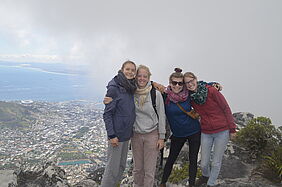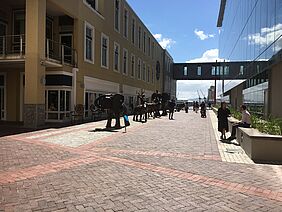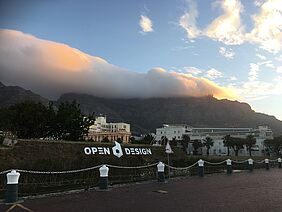It was grey. Everywhere. Overhead, underfoot, left, right, front, back. We were standing above Cape Town. Literally. At least, we assumed that we were doing this because we did not see anything. Hold on, there was a small hole in the cloud cover. A patch of blue showed up. The first buildings appeared: the stadium, the Victoria-and-Albert Waterfront, the harbor. Lion’s Head and Signal Hill slowly emerged from the clouds. Together with Devil’s Peak and Table Mountain these two landmarks dominate the skyline of Cape Town.
Table Mountain was voted as one of the New Seven Wonders of Nature in 2011. Therefore it is mentioned in the same breath with the Amazonas Rainforest and the Komodo Islands. It is also the only „wonder“ which is located in the middle of a city. It would have only taken us roughly half an hour through the city centre to get there, if there would have been no traffic. With the traffic (and including a shuttle tour plus a few extra kilometers of walking) our journey took us almost 1.5 hours. Eventually we reached the starting point of the Platteklip Gorge Walk. „Easy walk, partially rocky. Even my parents did it in their sixties“ the woman in our hostel told us. Well, it was not really like this. „Easy walk“ seems to mean „almost vertical ascent at times“, „partially rocky“ turned out to be „big rocks and small rocks alternating“. Still this walk is well worth doing it. Every time we stopped and turned around, the view almost knocked us off our feet. Again and again. Diving into the clouds on top of Table Mountain and walking through them is definitely an experience. And finally seeing Cape Town stretching out underneath your feet is incredible.
As the first colonial settlement (established in 1652) Cape Town is also known as the Mother City. Before the Dutch settlers set up their supply station here the region around „Hoerikwaggo“ (= Mountain of the Sea; the original name of Table Mountain) was inhabited by the San and the Khoi people. The Dutch expelled them from the area and erected the Fort de Goede Hoop, nowadays known as the Castle of Good Hope. The significant pentagon-like formed building is the only, originally preserved building in South Africa. During our Cape Town weekend it was also the venue for Open Design Afrika, an event dealing with the development of a better future for the world through innovation, education and design. Apart from the festival-like weekend there was also a day full of talks and discussions on Monday. We reached on time for Kevins keynote talk and stayed for the rest of the day. We got to know the ideas of people especially from South Africa but also from all over the world who are trying to make a difference. Sometimes in regional dimensions (like a paddling club in a Capetonian township), sometimes nationwide (like the initiative from and for girls in whole South Africa) and sometimes with the approach to bring the whole world together (like the Belgium artist tattooing the Declaration of Human Rights letter by letter onto the skin of people from everywhere).
Filled with new ideas and inspired to the limit we went back to Observatory, where our temporary home was.
And it really felt like home there. Situated in the heart of the neighbourhood our bohemian-style hostel turned out to be the perfect place to let the new inspiration and ideas set and grow. Observatory itself has a vivid history as it was one of the few „grey“ suburbs during apartheid. Until today Obz, as it is known by the locals, kept its rainbow-vibes and arty-hippie culture. Strolling through the streets, looking into the art stores, vintage shops and cafés in the Victorian buildings we immediately felt like home when we arrived. And it was like saying „goodbye“ to a good friend when we left. Actually we did not say „good bye“. We said „See you soon, Cape Town.“
006_Fallen for Cape Town
Back


